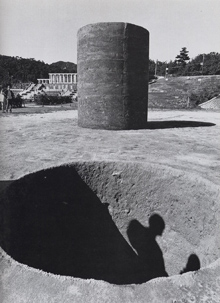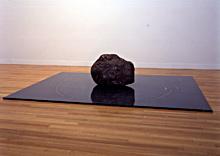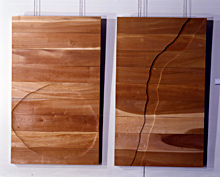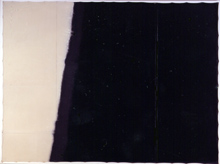4c
もの派
Mono-ha
【本文確定】
1968年10月、関根伸夫は第一回神戸須磨離宮公園現代彫刻展に「位相-大地」という作品を出品しました。これは大地に巨大な円筒形の穴を掘り、その傍らに穴から出た土砂を同形同大の円筒状に固めて配置したものです。関根伸夫の当初の意図はトリック・アート的なものでしたが、李禹煥はこれを見て「そのままの世界のあざやかさ、とでもいうべき感動的な表情を見せ伝える一つの物体と化している」と高く評価しました。すなわち物質や視覚に対する不信ではなく、物質の直接性が開く「あるがままの世界」を肯定したのです。この解釈の出現から、「もの派」が生まれました。すなわち関根伸夫らのグループに、西洋近代の超克を意図していた李禹煥が接近し、反主知主義の運動が起きたのです。関根伸夫らのグループとは、多摩美術大学の斎藤義重教室の門下生たちで、人気のあった高松次郎のゼミの受講生たちでした。
1969年、関根は2.5トンの油土(油粘土)を画廊内に不定形に配置し(「空相-油土」)、李禹煥はガラス板の上に重い石を置いてひびを入れました(「現象と知覚B」、のちに改題「Relatum」)。そして本田眞吾はテント布の中央に石を置き(「No.16」)、小清水漸は大きな紙の袋に石を入れ(「作品」)、成田克彦は角材を焼いて炭の塊とし(「SUMI 1」)、菅木志雄はパラフィンの板を多数積み上げそれをパラフィンの塀で囲み(「並列層」)、吉田克朗はロープの一端で角材を半吊りにし他端は床上の石に巻きつけました(「Cut-Off(hang)」)。評論家の峯村敏明によれば、「『モノ派』とは、1970年代前後の日本で、芸術表現の舞台に未加工の自然的な物質・物体 (いか『モノ』と記す) を、素材としてでなく主役として登場させ、モノの在りようやものの働きから直かに何らかの芸術言語を引き出そうと試みた一群の作家たちを指す」とされています(鎌倉画廊「モノ派」展カタログ、1986)*4c1。
ここで用語の整理をしておきます。「物体」は物理学の対象、「物質」は化学の対象で、「椅子という物体は、木という物質からできている」というふうに使います*4c2。しかし日本語の「物」は、「物体」と「物質」の両者を区別しないまま指し示す概念で、さらにそれを漢字で表記せずに「もの」と発音した場合、形式名詞や抽象的な強意語さえ含みます。「もの派」における「もの」には、これらすべてが含意されていると考えてもよいでしょう。しかしながら、たとえば椅子でなく原木が多用されたように、「物体」よりも「物質」に重点があったと指摘することも可能です。
「もの派」という呼称は、このような動向に対する揶揄として登場しました。造形行為の不在、すなわち創造性や理念の不在が言い当てられています。また、「概念性や名詞性のホコリをはらってものを見る」という関根伸夫の理解や、「ものが無名のまま在るという状況を放置する」という菅木志雄の主張とも、さほど矛盾しない呼称となっています*4c3。
松澤宥を筆頭とする日本概念派と対比すれば、もの派がもう一つの還元主義だったということが明らかです。ともに反芸術を受け継いで、絵画や彫刻という既成形式を捨て去ったまま、日本概念派は物質を捨象し概念性への還元を果たし、もの派は概念を捨象し物質性への還元を果たしたのだといえます。1970年、中原佑介が単独コミッショナーを務めた「人間と物質」展(東京ビエンナーレ ’70 第10回日本国際美術展、東京都美術館)は、これらの両傾向が際立ちを見せたことで記憶されています。同じ1970年には、日本概念派の作家が集結した「ニルヴァーナ 最終美術のために」(展と集会、京都市美術館)、もの派の作家が集められた「1970年8月 現代美術の一断面」展(東京国立近代美術館)も開催され、還元主義の二極化の図式が鮮明となりました。さらに、万博会場では万博芸術が大挙展覧されていたため、単なる進歩思想としてのモダニズムと、これら還元主義としての二つのモダニズムが*4c4、1970年には共存していたということになります。
もの派は、日本の固有性の呈示に初めて成功した美術運動であると言われることがあります。作家としては関根伸夫らのグループ(多摩美術大学系)以外に、物質よりは物体を呈示した原口典之ら(日本大学美術学科系)や、染みや滲みを呈示した榎倉康二、枕木を呪物化した高山登ほか(東京藝術大学系)を含めることもあります。さらに、共鳴者や追随者も含めると、一世を風靡した観のある大きなうねりでした*4c5。
In October of 1968, Sekine Nobuo exhibited a work called "Phase - Mother Earth" at the First Kobe Sumarikyu Park Contemporary Sculpture Exhibition. This work involved digging a huge cylindrical hole in the ground and placed a same sized cylinder made out of dirt which was dug out from the hole next to it. Sekine's initial intent was that of Trick Art, but seeing it, Lee U-Fan gave a high praise for the work by remarking that "It has become a singular object which shows an impressive expression which can be described as a vividness of the world as it is." He made an affirmation of the directness of the physical materials which results in the "world as it is," and not his suspicion towards the materials and visuals. Thus "Mono-ha" was born from the emergence of this interpretation. Lee, who has been challenging the influences of Western modernism, approached Sekine and his group and this has resulted in the founding of the anti-intellectualism movement. Sekine and his group were disciples of Saito Yoshishige at Tama Art University, and studied at a popular seminar headed by Takamatsu Jiro.
In the following year of 1969, Sekine freely placed 2.5 tons of oil clay in a gallery ("Phase of Nothingness - Oil Clay") and Lee placed heavy rocks on glass panels, cracking them as a result ("Phenomena and Perception B," later renamed "Relatum"). Honda Shingo placed a rock in the middle of a tent cloth ("No.16"), Koshimizu Susumu placed a rock inside a large paper bag ("Work"), Narita Katsuhiko burned wood beams and made charcoal masses out of them ("SUMI 1"), Suga Kishio stacked large numbers of paraffin plates and surrounded them with fences also made out of paraffin plates ("Parallel Strata") and Yoshida Katsuro hung a wood beam halfway down with one end of the rope and tied a rock on the floor with the other end ("Cut-Off (Hang)"). According to art critic Minemura Toshiaki, "Mono-ha was a group of artists who introduced unprocessed natural objects and matters (herein described as "Mono (things)") as the main theme and not as in raw materials, and attempted to draw out some type of art language directly from the state and function of Mono" (Kamakura Gallery "Mono-ha" exhibition catalog 1986)*4c1.
The word "objects" is used as it is in physics, and the word "matter" is used as it is in chemistry, and an example of the use of these words in such context would be: "The chair, which is an object, is made out of a matter called wood"*4c2. But the Japanese word "Mono (thing)" refers to both "object" and "matter" without distinguishing them, and when this word is not written in Kanji (Chinese characters) and written in Hiragana, it would embody formal noun and abstract intensifier. It can be said that the word "Mono (thing)" in "Mono-ha (School of Mono)" connote both meanings. But as unprocessed woods have been used lot more than the chair, it can be pointed out that there was more focus on the "matter" rather than the "object."
The word "Mono-ha" was introduced as a banter towards the trends of the emergence of these artists. The absence of the act of molding or the absence of creativity and principles aptly describes the word and thus the banter is superb. The word is not too far from Sekine's interpretation of "seeing Mono (things) by brushing the dust off of conceptualism or nominalization" or "leave the situation in which a nameless Mono (thing) exists as it is" as argued by Suga*4c3.
If it contrasts with the Japanese Conceptualists headed by Matsuzawa Yutaka, it is clear that the Mono-ha, with its aforementioned discourse, is yet another reductionism towards other direction. In line with the post-anti-art tradition, both have rejected the ready-made style of paintings and sculptures, but the Japanese conceptualists abstracted materials and reduced it down to conceptualism whereas Mono-ha abstracted concepts and reduced it down to materiality. The exhibition commissioned exclusively by Nakahara Yusuke, "Between Man and Matter" [訳変20090124]held as part of "Tokyo Biennale '70: 10th Japan International Art Exhibitions," is remembered for its demonstration of how both tendencies stood out from each other. In the same year, the exhibition and the meeting "Nirvana - For the Final Art" held at the Kyoto City Art Museum in which Japanese conceptualist artists gathered to exhibit their works and the exhibition "August 1970 - A Cross Section of Modern Art" held at the National Museum of Modern of Art in Tokyo in which Mono-ha artists gathered to exhibit their works made the polarization of reductionism clear. Because the Expo-Art works at the World Exposition venues were exhibited en masse, 1970 saw the two modernisms based on reductionism coexisting with modernism based on mere progressive ideology*4c4.
It is said that Mono-ha was the first art movement which succeeded in presenting art with inherent Japanese characteristics. The artists, aside from Sekine and his group from Tama Art University, include Haraguchi Noriyuki and others from the Fine Arts Department of Nihon University who presented objects rather than matters, Enokura Koji with his use of stains and oozes in his works and Takayama Noboru and others from the Tokyo University of Fine Arts and Music who fetishized railroad ties. If sympathizers and followers are to be included, it was a huge swell of all the rage at that time*4c5.






